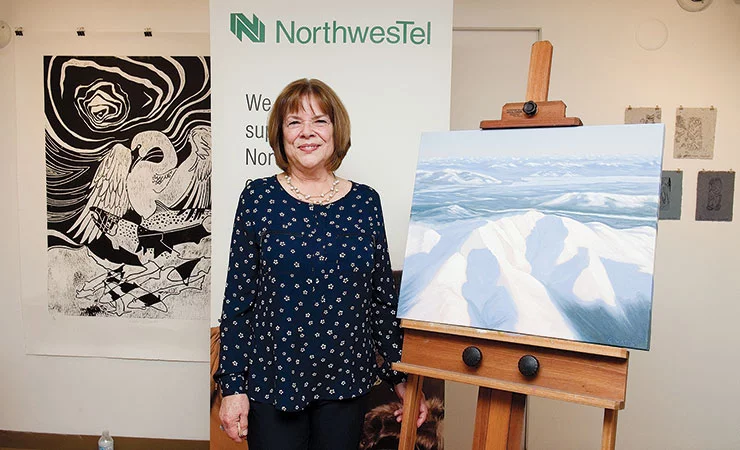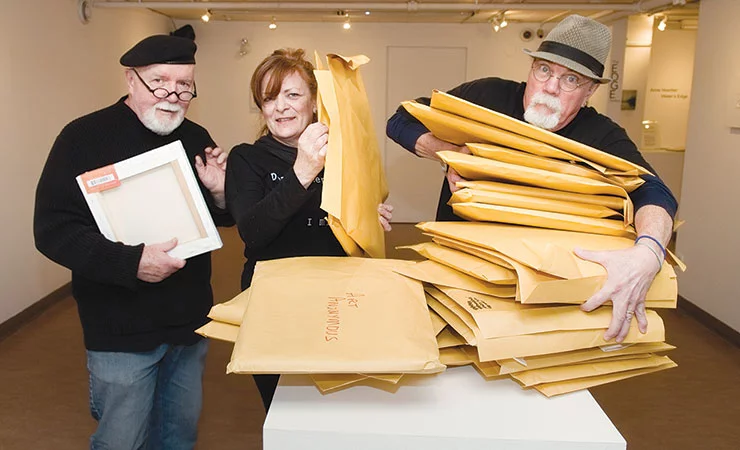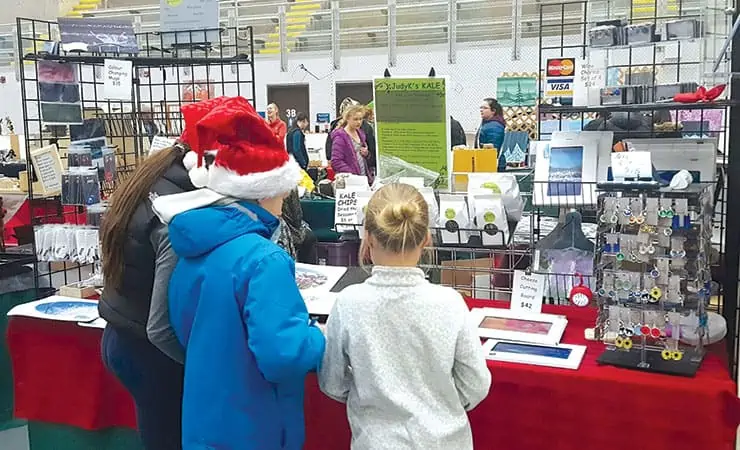Judy Matechuk’s show Through These Eyes succeeds best where she works deliberately with edges.
On the walls at Arts Underground you will find textile pieces made of glass laid over pieced-together fabric landscapes which may be stitched or paint-altered.
Sometimes photographs are digitally printed onto the fabric to create a background landscape, instead of piecing them together. Sometimes Matechuk sandblasts the glass with photographic images. And sometimes she prints colour images right onto the glass.
To my eye, the most successful sandblasted pieces are her Misty Mountain Alaskaseries, I, II and III. Matechuk uses the sandblasting to stand in for mist. It softens the edges between her green knit forests and marbled batik cotton mountains.
In II, she uses a warmer green in the more foreground area of forest, which creates depth more effectively than in some of the others. The strong shape of the greenish mountain in III carries the composition.
In Kluane Fireweed, Matechuk edges her textiles in stitching. She uses green thread, darker than the fabric, on the top edges of the green hills, and then a shiny silver thread contrasting the darker fabric of the grey hills. I enjoy the fireweed-like markings in the blue printed white textile she uses for the sky.
The dark green velvet cut with a slash of lighter green is effective in the low foreground hills, as is the wavy texture in the creased fabric she uses for the lake’s surface. In the foreground, what looks like wool for needle felting makes very soft-edges areas of pink and green, like masses of fireweed.
Then in the middle of the glass, greyish in tone against the textiles, a pixellated sandblasted image of a clump of fireweed jars me. Its visual language is so different from the rest of the piece that I wonder why it’s there.
In Looking Back toward Bove Island, Matechuk has trusted to her textiles to communicate her landscape. Its atmospheric shapes in blue, green and purple contrast the sky’s white horizon. They hover beneath a fine sheer cloth laid over the whole piece, which unifies it with a shimmer.
It is a challenge to create a range of hard and soft edges with cut fabric. In Unnamed Lake and Reflection, Matechuk succeeds at the horizon. In front of thin wafers of distant blue hills, black velvet stands in for black spruce. Black and green stitches at the fabric’s upper edge eloquently evoke the raggedy spruce tops. Stitching to the left subtly delineates a ridge within the bank.
The reflection is made using the same technique Matechuk uses for her printed cutting boards. She digitally prints her pieces onto the backs of pebbled glass architectural tiles. She has mirrored and inverted the landscape to create the reflection in this piece, as well as in two other pieces in the show.
In her tile table, River Rock, Matechuk has printed one of her photographs onto the back of the same pebbled glass tiles and mounted them into a welded table frame by her husband, Norm Matechuk.
When I look at these reproductions, I see considerable colour shifts from the original. This works reasonably well for the reflections in the lakes – the polarizing effects of being reflected off water can shift colour – but in the other two pieces I’m not as sure that Matechuk has complete control over the colour she’s printing out. I wonder if she needs to better calibrate her computer monitor and printer.
I found another strong edge in Long Beach. She has found the perfect fabric with permanently pressed-in waves for the ridged sand beach. Two simple figures fly kites at the waterline. Fraying the “sand” fabric and adding silvered threads at the edge of the water gives us a clear sense of breaking waves. The piece seems like it would be complete without the sandblasted stump in the lower right hand corner.
In View from the Alaska State Ferry to Juneau, I enjoy how the water’s horizon is not level – it gives me the sense of being at sea. I recognize the creased silk sky from light blue to grey from my own ferry trips. She’s chosen good fabrics full of rock lines, droplets and folds for the Southeast Alaskan mountains.
In the plain blue expanse of the water, a whale tail flips and drips. Here, the difference between this image in sandblasting and the landscape makes a kind of sense – the water and land remain the same, while the image in the glass might be the memory of a whale, present for a moment only.
Through These Eyes continues till November 10 at Arts Underground.



